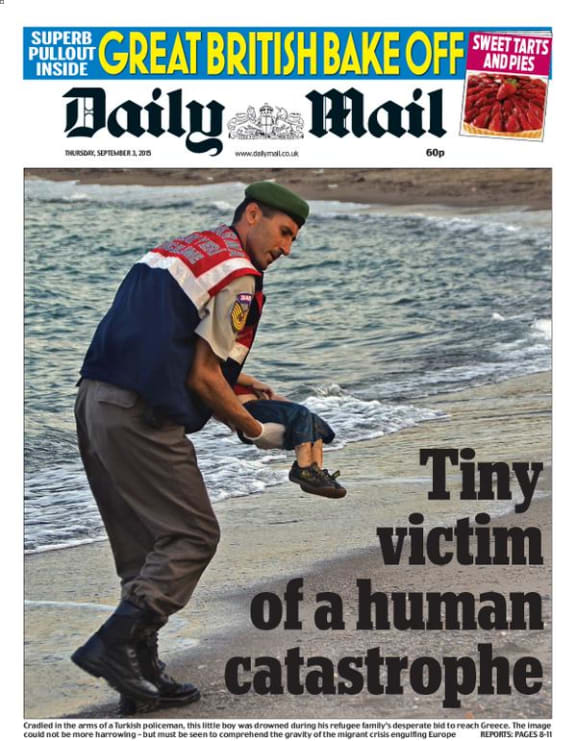Last week, images of the on-air shooting of a TV crew were broadcast and published all over the world, and shared widely online. One week later, photos of one young victim of Syria's refugee crisis touched a nerve, prompting more difficult decisions about what should be shown in the news.
The UK-based Guardian called it "a shocking image".
The full horror of the human tragedy unfolding on the shores of Europe was brought home on Wednesday as images of the lifeless body of a young boy encapsulated the extraordinary risks refugees are taking to reach the west.
On Thursday morning, The New Zealand Herald called them “harrowing,” Newstalk ZB called them “heartbreaking” and TV3 said they were “haunting".
But how should such stark images be shown? Some media published the pictures online with warnings that distressing images were on the page, including Radio New Zealand, which said:
Many news organisations, including Radio New Zealand, have chosen to publish only one photograph of the boy, in which he is being carried by a Turkish police officer and is unidentifiable.
The UK's Independent ran the most challenging pictures uncensored and without a warning online, under this headline: 'If these extraordinarily powerful images of a dead Syrian child washed up on a beach don't change Europe's attitude to refugees, what will?'

The UK's Daily Mail front page on Friday. Photo: screen shot
The next morning, the same picture filled up the entire front page of its print edition. The picture-hungry Mail Online site pixelated pictures of the boy's body on Thursday, but the group’s UK paper The Daily Mail had no such concerns the following morning.
Canada's public broadcaster CBC put the images at the bottom of an online story about the photos and told readers:
CBC News has decided to include the photos to allow for the fullest understanding of the event, but we want to give readers the option to not scroll down and click away if they don't want to see them.
The New York Times initially ran a story about the migrants' deaths with no images at all but when the images themselves became a news issue, the paper published them with claims being made about the pictures' political and ethical significance.
A number of reporters argued forcefully that it was necessary to confront the public with the human toll of the war in Syria . . . but many editors were concerned about shocking their readers and wanted to avoid the appearance of trafficking in sensational images for profit.
- New York Times
Social media changes the game
Millions around the world saw the images, whether they wanted to or not, on their social media feeds – without any warnings or angst about ethics.
Human Rights Watch’s emergency director Peter Bouckaert, working with migrants in Hungary, actively pushed the pictures out to his 25,000 followers, responding to those unhappy about it like this:
What is offensive is dead kids washing up on our beaches when deaths could have been prevented by EU action, not the pictures themselves.
— Peter Bouckaert (@bouckap) September 2, 2015
Canada-based journalism professor Alf Hermida, author of the book Tell Everyone, says journalists have always had to ask themselves whether publishing graphic images is in the public interest.
Now, he says, everyone shares that responsibility. "Everyone is the media now."
When are images of death newsworthy?
While people may be upset by seeing those images of the dead Syrian child – whether in the news media or on social media – they certainly illustrated an urgent political issue that’s on the political agenda all over the world.
But the same can’t be said of other distressing images of death that have been in our news lately – especially online.
Seven days earlier, startling images of another death overseas made headlines around the world when a TV crew was shot dead live on air in the US. Many outlets didn't show the moment the pair were shot, but media commentator Gavin Ellis said too much that was too graphic was aired and published.
On Nine to Noon, the former editor in chief of the New Zealand Herald said it is now time to “put some pegs in the ground” on the issue.
And Gavin Ellis isn’t the only one.
On Facebook, people urged TVNZ to take down a video with this heading:
GRAPHIC WARNING: Horrific moment journalist and cameraman shot dead during live broadcast
The Privacy Commissioner John Edwards complained to the Online Media Standards Authority about it. He thought the words clearly implied the footage actually showed the pair being killed, though TVNZ froze before the pictures before the fatal shots were fired.
“We strove to portray a terrible real-life event without showing gratuitous images, balancing the public’s right to know about an important story with taste and decency considerations”
- TVNZ
But there is footage of other people losing their lives on TVNZ’s news website.
In July, a woman who pushed her young son to safety before falling to her death under an escalator in a shopping mall in China. It was captured on CCTV and the video went viral in China. The OMSA said this was a matter of public interest, and the brief article provided sufficient context for the alarming video.
But there is hardly any context at all in another One News online video of a man being shot to death in South Carolina in April. There’s a ‘graphic warning’ on this video, but no freezing of the footage when he is shot. Aside from one line about the police officer being charged with murder, it’s hard to see how this could be an important story for an online audience of New Zealanders.
For decades, news photographers and camera operators have complained that editors have spiked shocking-but-revealing images on the grounds that the public would be upset by them.
Social media and changing public appetites may now be breaking down that barrier.

